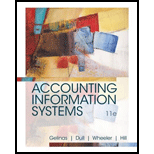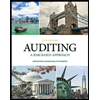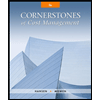
Accounting Information Systems
11th Edition
ISBN: 9781337552127
Author: Ulric J. Gelinas, Richard B. Dull, Patrick Wheeler, Mary Callahan Hill
Publisher: Cengage Learning
expand_more
expand_more
format_list_bulleted
Concept explainers
Question
Chapter 2, Problem 12RQ
Summary Introduction
To explain: The way an enterprise system supports the order – to – cash process.
Introduction:
Order –to – cash process:
It is a business process that involves the receiving and follows up of the requests of customers for the goods and services. It also contains many sub-processes.
Expert Solution & Answer
Trending nowThis is a popular solution!

Students have asked these similar questions
Explain.
The government finance which includes the principles and practices relating to the Procurement and management of funds for Central Government, and Local bodies is known as:
a.Public Finance
b.All of these
c.Private Finance
d.Business Finance
Explain.
The decisions relating to the use of profits or income of an entity or organization are known
a.Any of these
b.Dividend decisions
c.Finance decisions
d.Investment Decision
The degree correlation between risk and return over a longer period of time is generally …?
a.Highly negative
b.Non correlation
c.Negative
d.Highly positive
Chapter 2 Solutions
Accounting Information Systems
Ch. 2 - Prob. 1RQCh. 2 - Describe the key features/characteristics of an...Ch. 2 - Prob. 3RQCh. 2 - Describe the methods used to integrate ERP systems...Ch. 2 - Prob. 5RQCh. 2 - What is the relationship of the organizational...Ch. 2 - Prob. 7RQCh. 2 - Prob. 8RQCh. 2 - Prob. 9RQCh. 2 - Prob. 10RQ
Ch. 2 - Describe the six steps in the order-to-cash...Ch. 2 - Prob. 12RQCh. 2 - Prob. 13RQCh. 2 - How does an enterprise system support the...Ch. 2 - List the advantages and disadvantages of an...Ch. 2 - Prob. 1DQCh. 2 - The Tigris Company is considering taking customers...Ch. 2 - Periodically, you will read in the news about one...Ch. 2 - Describe how an enterprise system can assist an...Ch. 2 - Consider a business process that you have...Ch. 2 - Describe a situation in which information would be...Ch. 2 - Prob. 7DQCh. 2 - Prob. 8DQCh. 2 - Describe the primary and supporting activities...Ch. 2 - Prob. 1SPCh. 2 - Prob. 2SPCh. 2 - Prob. 3SPCh. 2 - Prob. 4SPCh. 2 - Conduct research on the Web sites of either CIO...Ch. 2 - Prob. 2PCh. 2 - Conduct research on an ERP package, such as...Ch. 2 - Prob. 4PCh. 2 - Prob. 5PCh. 2 - Prob. 6PCh. 2 - Choose (or you instructor may designate) an ERP...
Knowledge Booster
Learn more about
Need a deep-dive on the concept behind this application? Look no further. Learn more about this topic, finance and related others by exploring similar questions and additional content below.Similar questions
- The relationship of required rate of return and risk shows the linearity in the: a.None of these b.Capital market line c.Security market line d.Asset market linearrow_forwardPurchasing power of risk hit the investor when there are chances that the: a.None of these b.Real return on a security is equal to the nominal return c.Real return on a security is less than the nominal return d.Real return on a security is more than the nominal returnarrow_forwardneed help by real expert and true answer...arrow_forward
- What is the full form of "YTD"? a.Yield of Divergence b.Year to Delivery c.Year-to-date d.Yield to Debitarrow_forwardQuestion Three A company needs $10,000 in 5 years to replace a piece of equipment. How much must be invested now at an interest rate of 8% p.a. compounded daily in order to provide for this replacement?arrow_forwardYear Free Cash Flow (FCF) 0 -$17,000,000 1 $4,980,000 2 $4,980,000 3 $4,980,000 4 $4,980,000 5 $6,980,000 The Net Present Value at a discount rate of 15%: Present Value (PV) for each year: PV(Year 1) = $4,980,000 ÷ (1 + 0.15)^1 = $4,330,435. PV(Year 2) = $4,980,000 ÷ (1 + 0.15)^2 = $3,765,590. PV(Year 3) = $4,980,000 ÷ (1 + 0.15)^3 = $3,274,426. PV(Year 4) = $4,980,000 ÷ (1 + 0.15)^4 = $2,847,328. PV(Year 5) = $6,980,000 ÷ (1 + 0.15)^5 = $3,477,617. Sum of PVs = $4,330,435 + $3,765,590 + $3,274,426 + $2,847,328 + $3,477,617 = $17,695,396. Initial Investment = $17,000,000. NPV = Total PV - Initial Investment = $17,695,396 - $17,000,000 = $695,396. Calculate The Internal Rate of Returnarrow_forward
arrow_back_ios
SEE MORE QUESTIONS
arrow_forward_ios
Recommended textbooks for you
 Accounting Information SystemsAccountingISBN:9781337619202Author:Hall, James A.Publisher:Cengage Learning,
Accounting Information SystemsAccountingISBN:9781337619202Author:Hall, James A.Publisher:Cengage Learning, Auditing: A Risk Based-Approach (MindTap Course L...AccountingISBN:9781337619455Author:Karla M Johnstone, Audrey A. Gramling, Larry E. RittenbergPublisher:Cengage Learning
Auditing: A Risk Based-Approach (MindTap Course L...AccountingISBN:9781337619455Author:Karla M Johnstone, Audrey A. Gramling, Larry E. RittenbergPublisher:Cengage Learning Cornerstones of Cost Management (Cornerstones Ser...AccountingISBN:9781305970663Author:Don R. Hansen, Maryanne M. MowenPublisher:Cengage Learning
Cornerstones of Cost Management (Cornerstones Ser...AccountingISBN:9781305970663Author:Don R. Hansen, Maryanne M. MowenPublisher:Cengage Learning- Century 21 Accounting Multicolumn JournalAccountingISBN:9781337679503Author:GilbertsonPublisher:Cengage
 Cornerstones of Financial AccountingAccountingISBN:9781337690881Author:Jay Rich, Jeff JonesPublisher:Cengage Learning
Cornerstones of Financial AccountingAccountingISBN:9781337690881Author:Jay Rich, Jeff JonesPublisher:Cengage Learning

Accounting Information Systems
Accounting
ISBN:9781337619202
Author:Hall, James A.
Publisher:Cengage Learning,

Auditing: A Risk Based-Approach (MindTap Course L...
Accounting
ISBN:9781337619455
Author:Karla M Johnstone, Audrey A. Gramling, Larry E. Rittenberg
Publisher:Cengage Learning

Cornerstones of Cost Management (Cornerstones Ser...
Accounting
ISBN:9781305970663
Author:Don R. Hansen, Maryanne M. Mowen
Publisher:Cengage Learning

Century 21 Accounting Multicolumn Journal
Accounting
ISBN:9781337679503
Author:Gilbertson
Publisher:Cengage


Cornerstones of Financial Accounting
Accounting
ISBN:9781337690881
Author:Jay Rich, Jeff Jones
Publisher:Cengage Learning